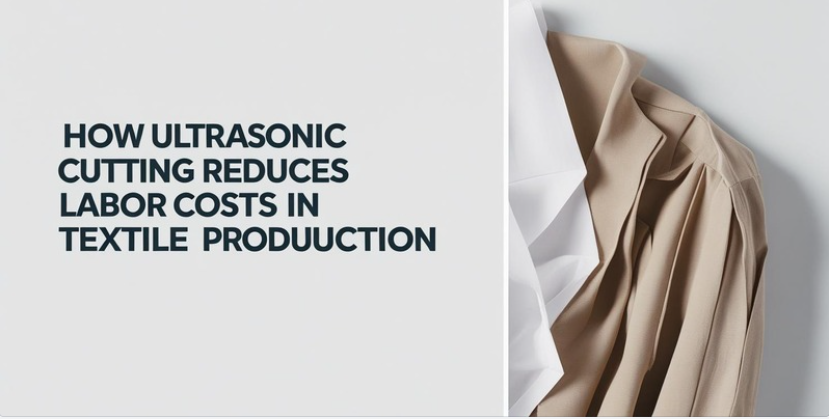How Ultrasonic Cloth Cutting Technology Helps Reduce Waste and Scrap
- ztzgsteeltech
- Jul 30
- 6 min read

In the textile manufacturing industry, material waste and production scrap are long-standing challenges that impact profitability and sustainability. Every inch of wasted fabric adds to costs, disrupts efficiency, and increases environmental impact.
With modern production demands tightening around precision, speed, and eco-conscious practices, businesses are turning toward advanced solutions like ultrasonic cloth cutting technology.
Ultrasonic cloth cutting machines are rapidly becoming a cornerstone of smart textile production.
They offer precise, clean, and consistent cuts with minimal material loss. The ability to cut synthetic and blended fabrics without fraying, edge discoloration, or misalignment is changing how manufacturers view fabric processing. This article takes a deep dive into how ultrasonic cutting systems significantly reduce waste and scrap, improving both operational performance and bottom-line savings.
Understanding Ultrasonic Cloth Cutting Technology
Ultrasonic cloth cutting machines use high-frequency vibrations to generate frictional heat at the cutting point. This localized energy melts and fuses synthetic or blended fabric edges as they are being cut, resulting in sealed edges that are clean, accurate, and resistant to fraying.
Unlike mechanical or laser cutting, which may rely on blades or intense heat, ultrasonic technology offers contactless or minimal-contact processing. This reduces material damage, especially in delicate or engineered textiles. The technology works exceptionally well on synthetic fabrics like polyester, nylon, acrylic blends, and certain non-woven materials.
Precision Cutting That Minimizes Material Loss
One of the most obvious ways ultrasonic cutting reduces waste is by improving cutting accuracy. When fabrics are cut with high precision, there is less margin for error. Whether you are cutting simple rectangular panels or intricate curves, ultrasonic cutters maintain exact shapes and sizes.
This level of precision ensures that more parts can be cut from each fabric roll. You’re no longer compensating for edge misalignment, irregular cuts, or misfeeds. The result is maximum yield from every roll of material, especially important when dealing with costly technical textiles or custom-designed prints.
Traditional cutting techniques often require added buffer zones to account for blade drift or alignment errors. With ultrasonic systems, that extra margin becomes unnecessary, further reducing off-cuts and waste.
No Fraying Means Less Rework and Scrap
Fabrics like polyester and nylon have a tendency to fray when cut with traditional blades. This leads to problems during assembly and finishing. Operators might need to trim edges, re-cut parts, or discard sections altogether, leading to higher scrap rates.
Ultrasonic cloth cutting technology seals the fabric edges as it cuts. This eliminates fraying and drastically reduces the need for reworking parts after cutting. By maintaining edge integrity, manufacturers save time, reduce waste, and ensure that every cut piece is ready for the next stage of production without modification.
This is especially useful in mass production scenarios where even a small percentage of defective cuts can translate into significant material loss.
Tighter Nesting and Pattern Optimization
Ultrasonic cutting systems are often used in conjunction with automated fabric feeding and nesting software. These tools help optimize fabric layouts by arranging cut patterns to fit tightly together, minimizing the space between individual parts.
Because ultrasonic cutters are so precise, they allow for tighter nesting patterns without the risk of overlapping or inaccurate cuts. This results in more efficient fabric usage per roll and less leftover material that would otherwise be discarded.
Even small improvements in nesting efficiency can lead to significant cost savings when scaled across thousands of production cycles. Combined with reduced edge defects, it’s easy to see how ultrasonic technology contributes to lean manufacturing goals.
Handling of Lightweight and Delicate Materials
Fabrics like organza, chiffon, or multi-layer composites can be extremely sensitive to blade-based cutting systems. These materials can tear, shift, or distort under the pressure of rotary or straight knives, causing high rejection rates.
Ultrasonic cutters gently apply localized vibrations, minimizing the risk of stretching or misalignment during cutting. This technology stabilizes the material during processing, preserving the structural integrity of even the thinnest fabrics.
By ensuring accurate cutting without distortion, ultrasonic machines eliminate a key source of scrap in lightweight textile production lines. Instead of dealing with cut pieces that fail quality checks, manufacturers can maintain higher consistency across batches.
Reduced Operator Errors Through Automation
Manual cutting processes are prone to human error. Misalignments, improper measurements, or fatigue-related mistakes can lead to off-spec parts and wasted material. Ultrasonic cloth cutting machines often feature automation options like programmable templates, laser guides, or CNC controls.
These automation features standardize the cutting process, eliminating reliance on operator skill or constant supervision. Once the machine is programmed, it performs the same high-quality cuts repeatedly, with minimal variation.
This consistency reduces error-induced scrap and contributes to a smoother, faster production flow. Less rework means fewer interruptions, lower labor costs, and more productive use of every fabric roll.
Heat-Free and Clean Cutting for Non-Synthetic Fabrics
While ultrasonic technology is most commonly used for synthetic materials, many machines today can handle natural and blended fabrics using cold cutting options. These methods use vibration energy without producing excessive heat.
With careful configuration, ultrasonic cloth cutters can cleanly process cotton, viscose, and blended materials while reducing edge residue or dust. The cutting quality remains high, and the chance of generating unusable offcuts is minimized.
This flexibility allows manufacturers to expand their fabric range without investing in different cutting equipment for each material type, reducing operational redundancy and inventory waste.
Lower Tool Wear and Maintenance-Related Scrap
Conventional cutting methods, especially blade-based systems, suffer from tool degradation over time. As blades dull, they cause inconsistent cuts, jagged edges, or partial separations, leading to increased waste until the blade is replaced.
Ultrasonic cutting systems experience significantly lower tool wear since the cutting energy comes from high-frequency vibration, not mechanical force. The result is cleaner cuts for longer periods, reducing the occurrence of defects due to blade wear.
With fewer maintenance interruptions and better overall reliability, ultrasonic machines help keep production lines running efficiently, lowering the risk of material loss due to mechanical inconsistencies.
Material Usage Reporting and Real-Time Feedback
Some ultrasonic cloth cutting machines integrate with smart sensors and monitoring software. These tools track material usage in real time, identifying potential inefficiencies or waste patterns before they become costly.
By analyzing cut accuracy, speed, and material consumption, operators can fine-tune settings to minimize overcuts, misalignments, or feeding issues. This closed-loop feedback helps improve material efficiency and identify performance bottlenecks.
With data-driven optimization, manufacturers can make informed decisions about batch sizes, cutting sequences, and machine calibration to further reduce scrap rates.
Cleaner Work Environment Equals Less Contamination Waste
Traditional cloth cutting methods often create lint, debris, and fiber residue, especially when processing multiple fabric types in one facility. These contaminants can stick to machine components, interfere with sensors, or damage sensitive materials like medical-grade fabrics.
Ultrasonic cutting produces far less particulate waste. Its vibration-based action reduces friction and thermal degradation, keeping the work surface cleaner. In sensitive production environments, this lowers the risk of contamination and the resulting waste from rejected parts.
Clean processing also simplifies machine maintenance and enhances the overall hygiene of the production floor, especially important in applications like cleanroom garments or food-contact textiles.
Scaling Sustainability Goals Through Waste Reduction
Sustainability is becoming a competitive advantage in the textile industry. Brands and manufacturers are under increasing pressure to lower their environmental footprint and adopt greener processes.
Ultrasonic cloth cutting technology supports this effort by significantly reducing material waste, which is one of the largest contributors to production-related environmental impact. By maximizing fabric yield, reducing rework, and enabling precise pattern execution, ultrasonic systems help businesses move toward zero-waste manufacturing.
For companies with sustainability certifications or circular economy goals, the integration of ultrasonic cutting equipment becomes a valuable step toward measurable environmental improvements.
Conclusion: A Smarter Way to Cut, Save, and Grow
Ultrasonic cloth cutting machines are not just about precision or speed. They offer a complete value proposition that includes reduced waste, improved material yield, lower scrap rates, and streamlined workflows. Whether you’re producing high-volume garments, technical textiles, or customized fabric components, this technology provides the edge you need to stay efficient and competitive. Buy the latest china ultrasonic cloth cutting machine from ZrinTech, because they are trusted and are working in ultrasonic machines industry from a long time.
By investing in ultrasonic cloth cutting technology, manufacturers gain the ability to minimize waste at every stage of production. This leads to better profit margins, cleaner operations, and a stronger alignment with sustainability standards that today’s markets demand.
If reducing material waste and cutting costs is a priority for your business, ultrasonic cutting technology is a solution worth serious consideration.



Comments